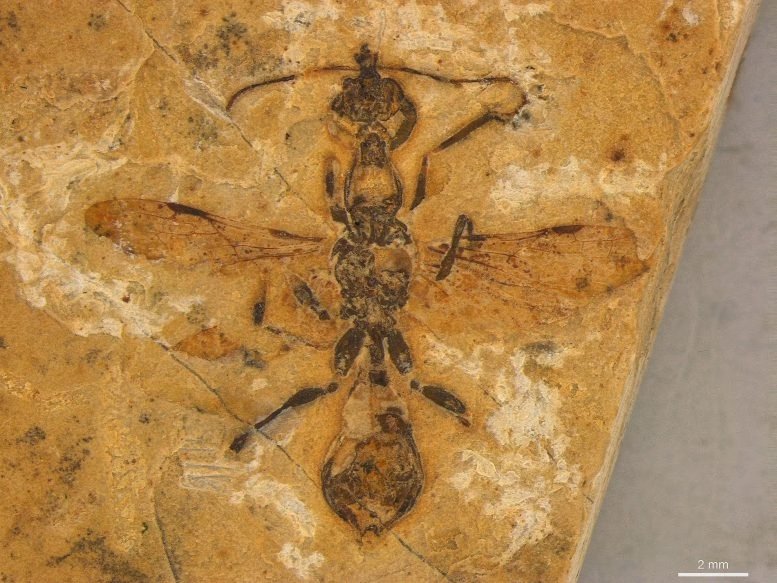Unveiling the Oldest Ant Fossil: 113-Million-Year-Old Hell Ant with Deadly Scythe Jaws
In a groundbreaking discovery, scientists have unearthed the oldest known ant fossil, a 113-million-year-old specimen from northeastern Brazil, shedding new light on the evolutionary history of ants. Published in the prestigious journal *Current Biology*, this remarkable find introduces a new species from the extinct Haidomyrmecinae subfamily, known as “hell ants” for their fearsome, scythe-like jaws. Preserved in limestone from the Crato Formation, this fossil not only rewrites the timeline of ant evolution but also highlights the incredible diversity and adaptability of these ancient insects during the Cretaceous period. This article delves into the significance of this discovery, the unique predatory features of the hell ant, and its implications for understanding insect evolution.
A Glimpse into the Cretaceous: The Oldest Ant Fossil
The recently discovered fossil, which dates to 113 million years ago and was found in Brazil’s Crato Formation, is the earliest uncontested record of ant geology. Unlike previously known ant fossils preserved in amber from France and Myanmar, this specimen was encased in limestone, offering a rare glimpse into the ancient world. The Crato Formation, a geological treasure trove in northeastern Brazil, is renowned for its exceptional preservation of fossils, making it a hotspot for paleontological discoveries. As a member of the extinct Haidomyrmecinae subfamily, this hell ant exhibits a lineage that flourished only during the Cretaceous epoch, when dinosaurs roamed the planet.
“This fossil is a game-changer,” said Anderson Lepeco, a researcher from the Museu de Zoologia da Universidade de São Paulo in Brazil. “It’s not just a new species—It is the oldest ant specimen yet discovered and a member of the mysterious hell ant group, which is distinguished by its strange and extremely specialized predatory characteristics. This discovery pushes back our understanding of when and how ants evolved their complex behaviors.”
The hell ant’s discovery challenges long-held assumptions about the timeline and geographic spread of early ants. The oldest ant fossils, which date to approximately 100 million years ago, were previously discovered in amber deposits in France and Myanmar. The Brazilian fossil, however, suggests that ants had already diversified and spread across multiple continents much earlier than previously thought. This finding underscores the global distribution of ants during the Cretaceous and hints at their ability to adapt to diverse environments millions of years ago.

Hell Ants: Predators with Scythe-Like Jaws
What sets hell ants apart from their modern counterparts is their extraordinary anatomy, particularly their scythe-like mandibles. Unlike today’s ants, which have mandibles that move laterally to grasp or chew, hell ants possessed forward-projecting jaws that likely functioned like deadly traps. These specialized mandibles, paired with a facial projection anterior to the eyes, suggest that hell ants were formidable predators capable of pinning or impaling their prey with precision.
Lepeco clarified, “These jaws are unlike anything we see in modern ants.” The ant’s distinctive feeding mechanism, which consisted of mandibles extending parallel to the head, probably made it possible for it to effectively paralyze prey. This level of specialization in such an ancient species is astonishing and suggests that hell ants had already developed sophisticated hunting strategies by the Cretaceous period.”
To uncover the intricate details of this fossil, researchers employed micro-computed tomography (micro-CT), a cutting-edge 3D imaging technique that uses X-rays to create detailed internal visualizations. The scans revealed that the Brazilian hell ant shares close similarities with other hell ant specimens previously found in Burmese amber. This connection indicates that hell ants were not confined to a single region but were widespread across Cretaceous landmasses, likely migrating across continents during a time when the Earth’s landmasses were still interconnected.
The Crato Formation: A Paleontological Goldmine
The Crato Formation, a limestone deposit in northeastern Brazil renowned for its remarkable preservation of ancient life forms, is largely responsible for the discovery of the hell ant fossil. The formation has yielded a wealth of fossils, including plants, fish, and insects, providing a snapshot of the Cretaceous ecosystem. The hell ant specimen was uncovered during a systematic examination of one of the world’s largest fossil insect collections, housed at the Museu de Zoologia da Universidade de São Paulo.
“The significance of this specimen was immediately apparent when we discovered it,” Lepeco remarked. It was more than simply another fossil; it was evidence of the diversity of Brazil’s fossil record and a window into the early evolution of ants. This discovery highlights the importance of revisiting existing collections in museums and private institutions, as they often hold untapped treasures that can reshape our understanding of the past.”
The Crato Formation’s limestone matrix preserved the hell ant in remarkable detail, allowing scientists to study its anatomy with unprecedented clarity. Unlike amber fossils, which are more common for preserving insects, limestone fossils are rarer and often more challenging to study. However, the exceptional preservation of this specimen enabled researchers to identify it as a new species and confirm its place as the oldest known ant fossil.
Rewriting Ant Evolution: Implications of the Discovery
The discovery of the 113-million-year-old hell ant raises profound questions about the evolutionary pressures that shaped these early insects. The presence of such specialized anatomical features in a fossil this ancient suggests that ants evolved complex predatory behaviors much earlier than previously thought. This finding challenges existing models of ant evolution, which assumed that such adaptations emerged later in their history.
“The intricate morphology of this hell ant indicates that evolutionary pressures during the Cretaceous were driving rapid diversification,” Lepeco noted. “These ants were already highly specialized, with traits that set them apart from modern ants. This suggests that the ecological niches they occupied were complex and demanded unique adaptations.”
The global distribution of hell ants, as evidenced by their presence in Brazil, France, and Myanmar, also points to their ability to traverse vast distances during the Cretaceous. At that time, the supercontinent Pangaea was breaking apart, creating new landmasses and environments. The hell ants’ ability to spread across these regions highlights their adaptability and resilience, traits that have made ants one of the most successful insect groups in history.
The Power of Advanced Imaging in Paleontology
Deciphering the mysteries of the hell ant fossil required the application of micro-CT imaging. This non-invasive technique allowed researchers to examine the specimen’s internal structures without damaging it, revealing details that would have been impossible to study otherwise. The scans confirmed the ant’s relationship to other hell ants and provided insights into its feeding apparatus, shedding light on how it hunted and survived in its prehistoric environment.
“Advanced imaging tools like micro-CT are revolutionizing paleontology,” said Lepeco. “They allow us to study fossils in ways that were unimaginable a few decades ago. With these tools, we can explore the finest details of ancient organisms, from their anatomy to their evolutionary relationships.”
The application of micro-CT also underscores the importance of integrating technology into paleontological research. As imaging techniques continue to improve, scientists can expect to uncover even more about the lives of ancient creatures, further refining our understanding of Earth’s distant past.

Brazil’s Role in Paleontological Discovery
The discovery of the hell ant fossil puts Brazilian paleontology in the spotlight, highlighting the country’s rich fossil record and its potential for future discoveries. The Crato Formation, in particular, is a critical resource for understanding the Cretaceous period, and this find emphasizes the need for continued exploration and preservation of Brazil’s geological heritage.
“Brazil has an incredible wealth of paleontological resources, but much of its insect fossil fauna remains underexplored,” Lepeco said. “This discovery is a call to action for researchers to delve deeper into our collections and field sites. There are likely many more species waiting to be uncovered.”
Conclusion: A New Chapter in Ant Evolution
The 113-million-year-old hell ant fossil from Brazil is more than just a remarkable find—it’s a key to unlocking the early history of one of Earth’s most successful insect groups. With its scythe-like jaws and specialized anatomy, this ancient predator challenges our understanding of ant evolution and highlights the diversity of life during the Cretaceous period. By combining advanced imaging techniques with meticulous fossil analysis, researchers have opened a new chapter in paleontology, one that underscores the importance of revisiting existing collections and exploring untapped geological sites.
As scientists continue to study this extraordinary specimen, the hell ant serves as a reminder of the complexity and resilience of life on Earth. Its discovery not only reshapes our understanding of ant evolution but also inspires future research into the ancient ecosystems that shaped our planet. For now, the hell ant stands as a testament to the power of paleontology to uncover the secrets of the past, one fossil at a time.
know more|| Visit BB
